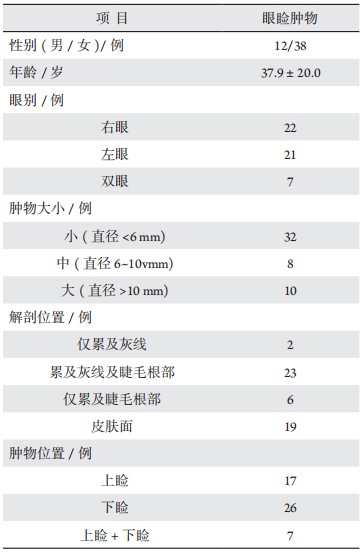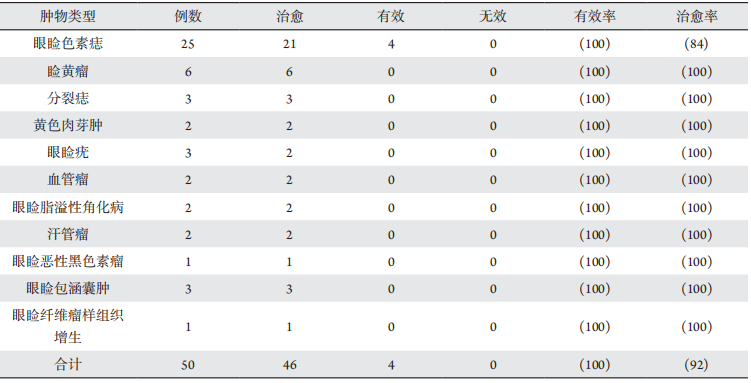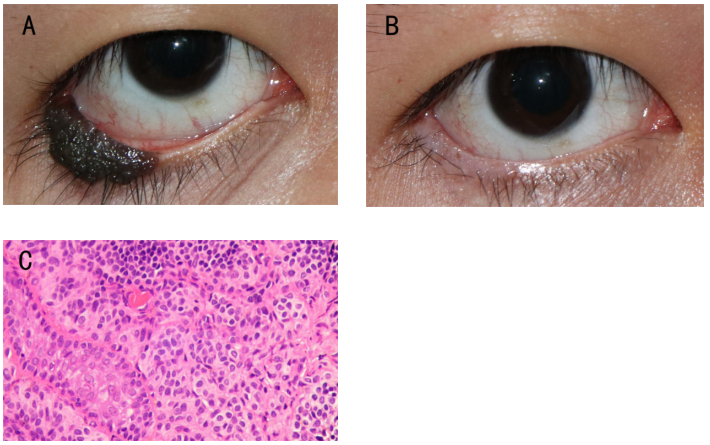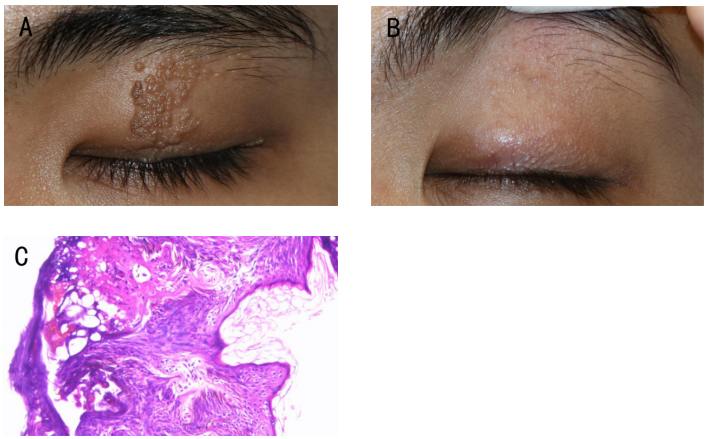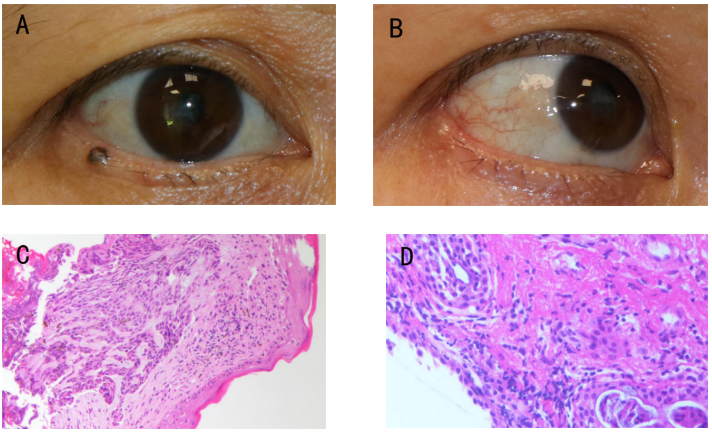1、Downie LE, Bandlitz S, Bergmanson JPG, et al. CLEAR - Anatomy and physiology of the anterior eye[J]. Cont Lens Anterior Eye, 2021, 44(2): 132-156.Downie LE, Bandlitz S, Bergmanson JPG, et al. CLEAR - Anatomy and physiology of the anterior eye[J]. Cont Lens Anterior Eye, 2021, 44(2): 132-156.
2、Herwig-Carl%20MC%2C%20L%C3%B6ffler%20KU.%20Eyelid%20tumors%3A%20clinical%20aspects%20of%20ophthalmic%20pathology%5BJ%5D.%20Klin%20Monbl%20Augenheilkd%2C%202018%2C%20235(7)%3A%20776-781.%0AHerwig-Carl%20MC%2C%20L%C3%B6ffler%20KU.%20Eyelid%20tumors%3A%20clinical%20aspects%20of%20ophthalmic%20pathology%5BJ%5D.%20Klin%20Monbl%20Augenheilkd%2C%202018%2C%20235(7)%3A%20776-781.%0A
3、Goto H, Yamakawa N, Komatsu H, et al. Epidemiological characteristics of malignant eyelid tumors at a referral hospital in Japan[J]. Jpn J Ophthalmol, 2022, 66(4): 343-349.Goto H, Yamakawa N, Komatsu H, et al. Epidemiological characteristics of malignant eyelid tumors at a referral hospital in Japan[J]. Jpn J Ophthalmol, 2022, 66(4): 343-349.
4、Gniesmer S, Sonntag SR, Schiemenz C, et al. Diagnosis and treatment of malignant eyelid tumors[J]. Ophthalmologie, 2023, 120(3): 262-270.Gniesmer S, Sonntag SR, Schiemenz C, et al. Diagnosis and treatment of malignant eyelid tumors[J]. Ophthalmologie, 2023, 120(3): 262-270.
5、Liu J, Sun J, Wang Z, et al. Treatment of divided eyelid nevus with orbicularis oculi myocutaneous flap: report of 17 cases[J]. Ann Plast Surg, 2020, 85(6): 626-630.Liu J, Sun J, Wang Z, et al. Treatment of divided eyelid nevus with orbicularis oculi myocutaneous flap: report of 17 cases[J]. Ann Plast Surg, 2020, 85(6): 626-630.
6、Torto FL, Losco L, Bernardini N, et al. Surgical treatment with locoregional flaps for the eyelid: a review[J]. Biomed Res Int, 2017, 2017: 6742537.Torto FL, Losco L, Bernardini N, et al. Surgical treatment with locoregional flaps for the eyelid: a review[J]. Biomed Res Int, 2017, 2017: 6742537.
7、Zhao S, Duan J, Zhang J, et al. Evaluation of meibomian gland function after therapy of eyelid tumors at palpebral margin with super pulse CO2 laser[J]. Dis Markers, 2022, 2022: 8705436.Zhao S, Duan J, Zhang J, et al. Evaluation of meibomian gland function after therapy of eyelid tumors at palpebral margin with super pulse CO2 laser[J]. Dis Markers, 2022, 2022: 8705436.
8、Zhang J, Duan J, Gong L. Super pulse CO2 laser therapy for benign eyelid tumors[J]. J Cosmet Dermatol, 2018, 17(2): 171-175.Zhang J, Duan J, Gong L. Super pulse CO2 laser therapy for benign eyelid tumors[J]. J Cosmet Dermatol, 2018, 17(2): 171-175.
9、Rentka A, Grygar J, Nemes Z, et al. Evaluation of carbon dioxide laser therapy for benign tumors of the eyelid margin[J]. Lasers Med Sci, 2017, 32(8): 1901-1907.Rentka A, Grygar J, Nemes Z, et al. Evaluation of carbon dioxide laser therapy for benign tumors of the eyelid margin[J]. Lasers Med Sci, 2017, 32(8): 1901-1907.
10、富秋涛, 魏宁, 孟辉, 等. 超脉冲CO2激光治疗睑缘分裂痣疗效观察[J]. 激光生物学报, 2019, 28(1): 80-83.
Fu QT, Wei N, Meng H, et al. Efficacy of ultrapulse CO2 laser treatment divided nevus of the eyelid[J]. Acta Laser Biol Sin, 2019, 28(1): 80-83.富秋涛, 魏宁, 孟辉, 等. 超脉冲CO2激光治疗睑缘分裂痣疗效观察[J]. 激光生物学报, 2019, 28(1): 80-83.
Fu QT, Wei N, Meng H, et al. Efficacy of ultrapulse CO2 laser treatment divided nevus of the eyelid[J]. Acta Laser Biol Sin, 2019, 28(1): 80-83.
11、曾颖, 罗益金, 占魁. CO2激光治疗睑缘色素痣的临床观察[J]. 应用激光, 2020, 40(4): 768-771.
Zeng Y, Luo YJ, Zhan K. Clinical observation on palpebral margin melanocytic naevus with super pulsed CO2 laser treatment[J]. Appl Laser, 2020, 40(4): 768-771.曾颖, 罗益金, 占魁. CO2激光治疗睑缘色素痣的临床观察[J]. 应用激光, 2020, 40(4): 768-771.
Zeng Y, Luo YJ, Zhan K. Clinical observation on palpebral margin melanocytic naevus with super pulsed CO2 laser treatment[J]. Appl Laser, 2020, 40(4): 768-771.
12、Mao Z, Lin BY, Huang YD, et al. Microscopic treatment of benign eyelid margin lesions with ultrapulse carbon dioxide (CO2) laser[J]. J Cosmet Laser Ther, 2021, 23(7-8): 184-187.
Mao Z, Lin BY, Huang YD, et al. Microscopic treatment of benign eyelid margin lesions with ultrapulse carbon dioxide (CO2) laser[J]. J Cosmet Laser Ther, 2021, 23(7-8): 184-187.
13、Varde MA, Murali KV, Wiechens B. Surgical treatment of eyelid tumors[J]. HNO, 2018, 66(10): 743-750.Varde MA, Murali KV, Wiechens B. Surgical treatment of eyelid tumors[J]. HNO, 2018, 66(10): 743-750.
14、Then SY, Malhotra R. Superiorly hinged blepharoplasty flap for reconstruction of medial upper eyelid defects following excision of xanthelasma palpebrum[J]. Clin Exp Ophthalmol, 2008, 36(5): 410-414.Then SY, Malhotra R. Superiorly hinged blepharoplasty flap for reconstruction of medial upper eyelid defects following excision of xanthelasma palpebrum[J]. Clin Exp Ophthalmol, 2008, 36(5): 410-414.
15、王越, 李洋, 侯志嘉, 等. 眼睑分裂痣的新分类法及整复手术效果 [J] . 中华眼科杂志, 2022, 58(9) : 676-681.
Wang Y, Li Y, Hou ZJ, et al. A new classification method of eyelid divided nevi and the effect of plastic surgical treatment[J]. Chin J Ophthalmol, 2022, 58(9): 676-681.王越, 李洋, 侯志嘉, 等. 眼睑分裂痣的新分类法及整复手术效果 [J] . 中华眼科杂志, 2022, 58(9) : 676-681.
Wang Y, Li Y, Hou ZJ, et al. A new classification method of eyelid divided nevi and the effect of plastic surgical treatment[J]. Chin J Ophthalmol, 2022, 58(9): 676-681.
16、Chin JKY, Yip W, Young A, et al. A six-year review of the latest oculoplastic surgical development[J]. Asia Pac J Ophthalmol, 2020, 9(5): 461-469.
Chin JKY, Yip W, Young A, et al. A six-year review of the latest oculoplastic surgical development[J]. Asia Pac J Ophthalmol, 2020, 9(5): 461-469.
17、Cho HJ, Lee W, Jeon MK, et al. Staged mosaic punching excision of a kissing nevus on the eyelid[J]. Aesthetic Plast Surg, 2019, 43(3): 652-657.
Cho HJ, Lee W, Jeon MK, et al. Staged mosaic punching excision of a kissing nevus on the eyelid[J]. Aesthetic Plast Surg, 2019, 43(3): 652-657.
18、Al-Niaimi F. Ultrapulsed CO2 ablation in the treatment of xanthelasma palpebrarum: high satisfaction treatment with low recurrence[J]. J Dermatolog Treat, 2022, 33(2): 1116-1118.
Al-Niaimi F. Ultrapulsed CO2 ablation in the treatment of xanthelasma palpebrarum: high satisfaction treatment with low recurrence[J]. J Dermatolog Treat, 2022, 33(2): 1116-1118.
19、Li D, Lin SB, Cheng B. CO2 laser treatment of xanthelasma palpebrarum in skin types III-IV: efficacy and complications after 9-month follow-up[J]. Photobiomodul Photomed Laser Surg, 2019, 37(4): 244-247.Li D, Lin SB, Cheng B. CO2 laser treatment of xanthelasma palpebrarum in skin types III-IV: efficacy and complications after 9-month follow-up[J]. Photobiomodul Photomed Laser Surg, 2019, 37(4): 244-247.
20、Krupa Shankar D, Chakravarthi M, Shilpakar R. Carbon dioxide laser guidelines[J]. J Cutan Aesthet Surg, 2009, 2(2): 72-80.
Krupa Shankar D, Chakravarthi M, Shilpakar R. Carbon dioxide laser guidelines[J]. J Cutan Aesthet Surg, 2009, 2(2): 72-80.
21、van Gemert MJC, Bloemen PR, Wang WY, et al. Periocular CO2 laser resurfacing: severe ocular complications from multiple unintentional laser impacts on the protective metal eye shields[J]. Lasers Surg Med, 2018, 50(10): 980-986.van Gemert MJC, Bloemen PR, Wang WY, et al. Periocular CO2 laser resurfacing: severe ocular complications from multiple unintentional laser impacts on the protective metal eye shields[J]. Lasers Surg Med, 2018, 50(10): 980-986.

